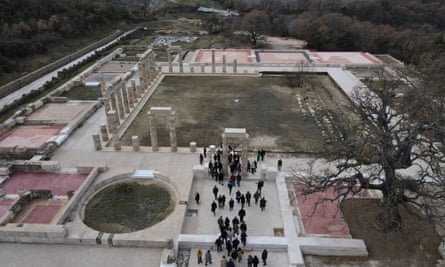For 2,170 years it had lain in ruins: a palace that symbolised the golden age of antiquity, three times bigger than the Parthenon, unprecedented in architectural ambition, unparalleled in beauty.
It was here in 336BC that the king of ancient Macedonia, Philip II, was murdered; and here in the great peristyle – or columned courtyard – around which its banqueting halls coalesced that his 20-year-old son, Alexander the Great, would be proclaimed king, a moment that would change the course of history.
This week, for the first time since its destruction at the hands of Roman invaders barely 200 years later, the Palace of Aigai, the largest surviving building from the classical Greek era, has resumed its past glory, with thousands visiting the reopened monument after the completion of its 16-year reconstruction.
For Kyriakos Mitsotakis, the Greek prime minister, who opened the site an hour’s drive west of the port city of Thessaloniki, its inauguration was replete with significance far beyond Greece. “The importance of such monuments transcends local boundaries,” he told the assembled crowd. “And we, as the custodians of this precious cultural heritage, must protect it, highlight it [and] promote it.”
For restorers who first began work in 2007 it was an achievement that at times had seemed an impossible dream.
“When we began what we confronted were tens of thousands of scattered architectural remains, a huge jigsaw puzzle of column bases and capitals [column tops], architraves, roof tile fragments and walls,” says Angeliki Kottaridi, the archaeologist who oversaw the €20.3m (£17.5m) EU-funded project. “To envision how it would have looked, then to piece it together and have that verified, was pure joy.”

The crowning glory of what had once been the royal metropolis of Macedonia, the palace was not just a model building but “an architectural manifesto of the ideal state,” according to Kottaridi. No other edifice, she said, came close in inventiveness, brilliance or architectural harmony.
Under a massive building programme ordered by Philip, Aigai was transformed into a sprawling city with the palace part of a complex that would include a theatre, sanctuary, library and vast necropolis of more than 500 burial mounds. Philip’s tomb is believed to be among them.
“Less than 10% [of the city] has been excavated,” enthused Kottaridi, who has worked at the Unesco world heritage site for close to half a century. “It is a gift that keeps on giving.”

The palace is among more than 800 monuments currently being upgraded in Greece thanks to financial help from the EU. With the centre-right government investing so heavily in the “cultural economy” Mitsotakis emphasised the role the site would play as a “catalyst” for growth across the region – along with it buttressing Greece’s identification with ancient Macedonia. Local officials agree.
“They’re calling it the Parthenon of Macedonia,” said Konstantinos Vorgiazides, the mayor of Veria, the nearest town to the archaeological treasures. “Every year the site draws about 250,000 tourists but now we are expecting it to increase greatly. We’re very proud. I was there for the inauguration. It’s a beautiful place.”
For historians inside and outside Greece the new palace does something better still: refocus attention away from the classical age of Pericles in Athens to the Macedonian dynasty of northern Greece and achievements of Philip and Alexander.
“History is always about what we focus on,” said the British historian and broadcaster Michael Wood, speaking from London. “And this focuses our attention on the incredible events that began there. This small, provincial, militaristic kingdom would be the catalyst for the spread of Greek culture and Aigai the launch pad for Alexander the Great’s adventure in history, his expedition to Asia and conquest of half the known world.”

If the Parthenon represented the peak of the classical age, the royal metropolis conjured the beginning of the Hellenistic age, one that would last for hundreds of years and be felt as far as Afghanistan and India.
But there was something else, said Wood, who retraced the young warrior king’s epic journey through deserts, mountain ranges, rivers and plains from Greece to the north-west frontier of Pakistan and India in the 1990s.
The palace’s reconstruction had shown, yet again, that like the Parthenon marbles, great historical monuments have “an integrity” best seen united in their natural landscape. “The modern Greek state, as it should be, is proving to be a pre-eminent guardian of its ancient Greek culture,” said Wood. “What the palace also does is draw attention to the fact that the fifth-century sculptures should all be in the same place, back in Athens.”